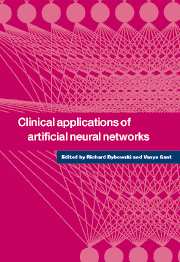Book contents
- Frontmatter
- Contents
- List of contributors
- 1 Introduction
- Part I Applications
- Part II Prospects
- Part III Theory
- 11 Neural networks as statistical methods in survival analysis
- 12 A review of techniques for extracting rules from trained artificial neural networks
- 13 Confidence intervals and prediction intervals for feedforward neural networks
- Part IV Ethics and clinical prospects
- Index
11 - Neural networks as statistical methods in survival analysis
Published online by Cambridge University Press: 06 October 2009
- Frontmatter
- Contents
- List of contributors
- 1 Introduction
- Part I Applications
- Part II Prospects
- Part III Theory
- 11 Neural networks as statistical methods in survival analysis
- 12 A review of techniques for extracting rules from trained artificial neural networks
- 13 Confidence intervals and prediction intervals for feedforward neural networks
- Part IV Ethics and clinical prospects
- Index
Summary
Introduction
Artificial neural networks are increasingly being seen as an addition to the statistics toolkit that should be considered alongside both classical and modern statistical methods. Reviews in this light have been given by one of us (Ripley 1993, 1994a–c, 1996) and Cheng & Titterington (1994) and it is a point of view that is being widely accepted by the mainstream neural networks community. There are now many texts (Hertz et al. 1991; Haykin 1994; Bishop 1995; Ripley 1996) covering the wide range of artificial neural networks; we concentrate here on methods that we see as most appropriate generally in medicine, and in particular on methods for survival data that have not to our knowledge been reviewed in depth (although Schwarzer et al. (1997) reviewed a large number of applications in oncology). In particular, we point out the many different ways classification networks have been used for survival data, as well as their many flaws.
Most applications of artificial neural networks to medicine are classification problems; that is, the task is on the basis of the measured features to assign the patient (or biopsy or electroencephalograph or …) to one of a small set of classes. Baxt (1995) gave a table of applications of neural networks in clinical medicine that are almost all of this form, including those in laboratories (Dybowski & Gant 1995).
Information
- Type
- Chapter
- Information
- Clinical Applications of Artificial Neural Networks , pp. 237 - 255Publisher: Cambridge University PressPrint publication year: 2001
Accessibility standard: Unknown
Why this information is here
This section outlines the accessibility features of this content - including support for screen readers, full keyboard navigation and high-contrast display options. This may not be relevant for you.Accessibility Information
- 22
- Cited by
